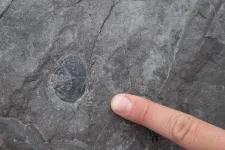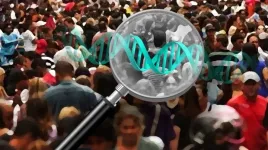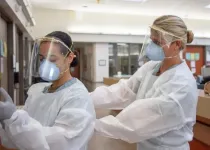(Press-News.org) CAMBRIDGE -- The temperature of a planet is linked with the diversity of life that it can support. MIT geologists have now reconstructed a timeline of the Earth's temperature during the early Paleozoic era, between 510 and 440 million years ago -- a pivotal period when animals became abundant in a previously microbe-dominated world.
In a study appearing today in the Proceedings of the National Academy of Sciences, the researchers chart dips and peaks in the global temperature during the early Paleozoic. They report that these temperature variations coincide with the planet's changing diversity of life: Warmer climates favored microbial life, whereas cooler temperatures allowed more diverse animals to flourish.
The new record, more detailed than previous timelines of this period, is based on the team's analysis of carbonate muds -- a common type of limestone that forms from carbonate-rich sediments deposited on the seafloor and compacted over hundreds of millions of years.
"Now that we have shown you can use these carbonate muds as climate records, that opens the door to looking back at this whole other part of Earth's history where there are no fossils, when people don't really know much about what the climate was," says lead author Sam Goldberg, a graduate student in MIT's Department of Earth, Atmospheric, and Planetary Sciences (EAPS).
Goldberg's co-authors are Kristin Bergmann, the D. Reid Weedon, Jr. Career Development Professor in EAPS, along with Theodore Present of Caltech and Seth Finnegan of the University of California at Berkeley.
Beyond fossils
To estimate Earth's temperature many millions of years ago, scientists analyze fossils, in particular, remains of ancient shelled organisms that precipitated from seawater and either grew on or sank to the seafloor. When precipitation occurs, the temperature of the surrounding water can change the composition of the shells, altering the relative abundances of two isotopes of oxygen: oxygen-16, and oxygen-18.
"As an example, if carbonate precipitates at 4 degrees Celsius, more oxygen-18 ends up in the mineral, from the same starting composition of water, [compared to] carbonate precipitating at 30 degrees Celsius," Bergmann explains. "So, the ratio of oxygen-18 to -16 increases as temperature cools."
In this way, scientists have used ancient carbonate shells to backtrack the temperature of the surrounding seawater -- an indicator of the Earth's overall climate -- at the time the shells first precipitated. But this approach has taken scientists only so far, up until the earliest fossils.
"There is about 4 billion years of Earth history where there were no shells, and so shells only give us the last chapter," Goldberg says.
A clumped isotope signal
The same precipitating reaction in shells also occurs in carbonate mud. But geologists assumed the isotope balance in carbonate muds would be more vulnerable to chemical changes.
"People have often overlooked mud. They thought that if you try to use it as a temperature indicator, you might be looking at not the original ocean temperature in which it formed, but the temperature of a process that occurred later on, when the mud was buried a mile below the surface," Goldberg says.
To see whether carbonate muds might preserve signatures of their original surrounding temperature, the team used "clumped isotope geochemistry," a technique used in Bergmann's lab, which analyzes sediments for clumping, or pairing, of two heavy isotopes: oxygen-18 and carbon-13. The likelihood of these isotopes pairing up in carbonate muds depends on temperature but is unaffected by the ocean chemistry in which the muds form.
Combining this analysis with traditional oxygen isotope measurements provides additional constraints on the conditions experienced by a sample between its original formation and the present. The team reasoned that this analysis could be a good indication of whether carbonate muds remained unchanged in composition since their formation. By extension, this could mean the oxygen-18 to -16 ratio in some muds accurately represents the original temperature at which the rocks formed, enabling their use as a climate record.
Ups and downs
The researchers tested their idea on samples of carbonate muds that they extracted from two sites, one in Svalbard, an archipelago in the Arctic Ocean, and the other in western Newfoundland. Both sites are known for their exposed rocks that date back to the early Paleozoic era.
In 2016 and 2017, teams traveled first to Svalbard, then Newfoundland, to collect samples of carbonate muds from layers of deposited sediment spanning a period of 70 million years, from the mid-Cambrian, when animals began to flourish on Earth, through the Ordovician periods of the Paleozoic era.
When they analyzed the samples for clumped isotopes, they found that many of the rocks had experienced little chemical change since their formation. They used this result to compile the rocks' oxygen isotope ratios from 10 different early Paleozoic sites to calculate the temperatures at which the rocks formed. The temperatures calculated from most of these sites were similar to previously published lower-resolution fossil temperature records. In the end, they mapped a timeline of temperature during the early Paleozoic and compared this with the fossil record from that period, to show that temperature had a big effect on the diversity of life on the planet.
"We found that when it was warmer at the end of the Cambrian and early Ordovician, there was also a peak in microbial abundance," Goldberg says. "From there it cooled off going into the middle to late Ordovician, when we see abundant animal fossils, before a substantial ice age ends the Ordovician. Previously people could only observe general trends using fossils. Because we used a material that's very abundant, we could create a higher-resolution record and could see more clearly defined ups and downs."
The team is now looking to analyze older muds, dating back before the appearance of animals, to gauge the Earth's temperature changes prior to 540 million years ago.
"To go back beyond 540 million years ago, we have to grapple with carbonate muds, because they are really one of the few records we have to constrain climate in the distant past," Bergmann says.
INFORMATION:
This research was supported, in part, by NASA and the David and Lucile Packard Foundation.
In a new study led by Yale Cancer Center, researchers have discovered a novel metabolic gatekeeper mechanism for leukemia. This mechanism depends on a molecule called PON2, which could lead to a new treatment for the disease. The findings were published online today in the Proceedings of the National Academy of Sciences (PNAS).
B cells are effector cells of the adaptive immune system and are marked by low energy levels, which prevent transformation to leukemia. In this study, Yale scientists identified high expression levels of the detoxifying lactonase ...
Philadelphia, February 1, 2021 - Researchers at Children's Hospital of Philadelphia (CHOP) have demonstrated that autism spectrum disorder (ASD) may be caused by defects in the mitochondria of brain cells. The findings were published online by the Proceedings of the National Academy of Sciences.
Multiple studies have revealed hundreds of mutations associated with autism spectrum disorder, but there is no consensus as to how these genetic changes cause the condition. Biochemical and physiological analyses have suggested that deficiencies in mitochondria, the "batteries" of the cell that produce ...
Scientists have identified a group of drugs that may help stop a leading cause of vision loss after making an unexpected discovery that overturns a fundamental belief about DNA.
The drugs, known as Nucleoside Reverse Transcriptase Inhibitors, or NRTIs, are commonly used to treat HIV. The new discovery suggests that they may be useful against dry macular degeneration as well, even though a virus does not cause that sight-stealing condition.
A review of four different health insurance databases suggests that people taking these drugs have significantly reduced risk of developing dry macular degeneration, a condition that affects ...
A 15-year experiment on Arctic shrubs in Greenland lends new understanding to an enduring ecological puzzle: How do species with similar needs and life histories occur together at large scales while excluding each other at small scales? The answer to this question has important implications for how climate change might shift species' distributions across the globe.
The study was published today in the journal PNAS and led by the University of California, Davis. Its findings also reveal trends related to carbon sequestration and carbon exchange as the Arctic becomes both greener and browner.
EXPANSION AND EXCLUSION
Like lines of traffic traveling the same roads at the same time without crashing into each ...
CLEVELAND - Evidence suggests particulate matter is the air pollutant which poses the greatest threat to global health. Studies have shown that exposure to particulate matter smaller than 2.5 microns is associated with acute and chronic elevations in blood pressure (BP) as well as hypertension. In the study "The Benefits of Intensive Versus Standard Blood Pressure Treatment According to Fine Particulate Matter Air Pollution Exposure" published this week in the journal Hypertension, researchers at University Hospitals (UH) and Case Western Reserve University (CWRU) ...
A paper by a multidisciplinary team of scientists affiliated with various Brazilian institutions, including the University of São Paulo (USP) and the National Cancer Institute (INCA), shows that people of African descent are less likely to find a donor in the National Register of Voluntary Bone Marrow Donors (REDOME) than people with predominantly European ancestry. The paper is published in Frontiers in Immunology.
REDOME is the world’s third-largest bone marrow bank, with more than 5 million registered voluntary donors.
According to the study, having mainly African genetic ancestry can reduce a person’s chances of finding a donor by up to 60%, and having African copies of HLA genes, which must be compatible with ...
Obesity and its duration are significant risk factors for type 2 diabetes, cardiovascular events, multiple cancers and decreased quality of life. According to the Centers for Disease Control and Prevention, obesity affects 20.6% of adolescents ages 12-19 in the United States, meaning a potential lifetime of dealing with this condition. Complications from obesity can also result in a potentially decreased life expectancy of five to 20 years for these youth. In a new study published in Pediatrics, researchers at Children's Hospital Colorado (Children's Colorado) have found that both younger and older adolescents have similar weight loss, resolution of high blood pressure and high cholesterol, nutritional impacts and improvement in quality of life after bariatric surgery. These results ...
Article Title: "Game theory to enhance stock management of Personal Protective Equipment (PPE) during the COVID-19 outbreak"
Funding: The authors received no specific funding for this work.
Competing Interests: The authors have declared that no competing interests exist.
Article URL: https://journals.plos.org/plosone/article?id=10.1371/journal.pone.0246110
INFORMATION: ...
Decoy protein intercepts spike of coronavirus
Virus prevented from infecting human cells
Protein may be new way to treat and prevent COVID-19
CHICAGO --- Northwestern Medicine scientists have developed a new protein that acts as a trickster to neutralize the COVID-19 infection in a human kidney organoid, a miniature organ made from stem cells in the lab.
The protein is a variant of ACE2 (angiotensin converting enzyme-2), the receptor the coronavirus uses to enter and infect human cells. The modified protein intercepts the S spike of the coronavirus and fools it into binding to it rather than the real ACE2 receptor in cell membranes. ...
NEW YORK, NY (Feb. 1, 2021)--Errors in the way chromosomes are packed into antibody-producing B cells appear to play a role in the development of B cell-related blood cancers, according to a new study by researchers at Columbia University Vagelos College of Physicians and Surgeons.
The findings could lead to new biomarkers for predicting the onset of these cancers and to a new class of cancer therapies that prevent or correct harmful changes in genome architecture.
The study was published online Feb. 1 in the journal Nature Genetics.
Antibodies are made by immune cells called ...






